This text originally appeared on www.aypt.at. It is also available in German.
The Great IYPT China Report
Let’s start with some good news: We came second in the physics world championship! Even better: We were the undefeated winners of the IYPT basketball tournament. But let’s start form the beginning, with the last preparations in Vienna.
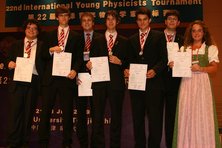 We came second in the physics world championship!
We came second in the physics world championship! The Last Days in Vienna
The last preparation seminar in Vienna, traditionally held on the days before departure, has always been something special. Nervousness and excitement about the upcoming trip and the tournament are continually on the rise. Also, the number of new ideas for improvements is reciprocally proportional to the remaining time. All the work that has been put off up to then finally needs to get done, when meanwhile it’s time to finish the presentations and do some practice fights.
A report of the first meeting has been published by Tim already. The second meeting was used to interpret results, perform experiments with improved setups, according to the experience we had gained, and try some completely new ideas. To produce “Sand ripples”, for example, Johannes built a wave machine with variable frequency (1Hz to audibility limit – made possible through a frequency generator), and all of a sudden our beloved lab was flooded! Angel and Tim put up the “Coupled Compasses” once more, now the intention was to mark the needles and evaluate the data automatically by image recognition. This time, the list of things we destroyed was surprisingly short: a 1-KW-lamp, a piece of foamed plastic that Angel cracked in his fist when it was cooled by liquid nitrogen, and a thin hose for which the pressure reducer apparently hadn’t been set sensitively enough. At some stage, even the huge flask filled with liquid nitrogen lost its fascination, given the interesting problems to be explored.
For a surprisingly long period of time, all the work was „almost done“. As the date of departure, July 18, was getting closer and closer, we urged to finally start presenting our reports. It was no less than four times that we went to the nearest McDonald’s restaurant to keep working there when the university closed for the night. At McDonald’s, we found everything we needed: enough space for our notebooks, power supply, internet access and, last but not least, fast food, which would become an important alternative to local Chinese food during our journey later on. This year, our presentations had reached such a high level of complexity that it was necessary to compile lists of devices needed for each presentation and to write down who would be responsible for each task.
- wine
- straw
- camera + wires + adapter
- beaker
- tissues
- notebook + presenatation slides + camera software
- corkscrew
- coat + assistant
- funnel
- dropstop
- stickytape
But the effort paid off, Markus’ presentation in the last prefight was crucial to beat two other teams and get the ticket for the finals.
On the Way to China
On July 18, we were sufficiently „almost ready” and made our way to the airport. Is it actually allowed to take the magnets that we need for „Electromagnetic motor” on board? A quick call would clarify the issue. No, magnets are generally prohibited. But in hard discs, for example, even stronger magnets are used!? Well yes, but they are switched off! Once more, we were reinforced in our intention to communicate physics to the world…
We decided to camouflage the magnets as accessories on Kathi’s clothes and Bernhard’s belt and had no problems to pass the security checks at the airport in Vienna. After the security’s doubtful glance at our experimental equipment, we explained that we were on the way to the physics world cup. No more questions were asked. Unintentionally, Kathi had mouthwash and coffee in her carry on luggage and took it on board, unnoticed by the security staff. Not even full-body scanners would help out in that case – although this idea does sound quite appealing…from the scientific point of view!
 Our team at the opening ceremony.
Our team at the opening ceremony.Once arrived in Beijing after a nice and calm flight, we found ourselves in a strong, artificial winter. We followed the human direction signs, all making elegant gestures pointing in one direction, and finally arrived at the fever check points. We passed it without any problems. At immigration, we are asked to rate the immigration officer on a scale of five smileys. All of us choose the best grade, as we were afraid that they might lose their jobs if they got bad ratings.
As impressive as the building of Beijing Airport might be, the temperature difference at the exit is at least equally impressing. We felt like we were diving into the heat, moisture and fog and couldn’t wait to get on the air-conditioned bus that was sent by the Nankai University. During the ride, some of us tried to catch up on sleep, while others took pictures of them doing so.
The Venue of the Tournament
The Nankai University in Tianjin is situated on a huge campus which is fenced and guarded by the university’s own security staff. Also our hotel was located on the campus. As long as you don’t expect a high standard, the rooms were quite good. The only thing we were short of was toilet rolls. In China, the latest trend in toilet rolls seemed to be tiny, extremely thin rolls which wouldn’t possibly be sufficient for even one person in Europe. Also, we had the problem that from the very first day on, there was always someone among our team members who suffered from diarrhea. The receptionist, smiling in a friendly way, informed us about the one-roll-policy that was maintained in this hotel, but offered to sell a huge package of European toilet paper to us. Converted back to Euros, the price was a few cents.
Whatever we were doing, it was accompanied by an impressive concert of crickets in incredible volume. At the first glance, this might sound interesting, but after some time, it was disturbing not only our sleep, but also the tournament. Even those among us who would usually support an animal rights activists’ point of view were longing for the most efficient poison…
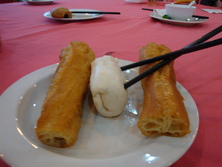 Breakfast.
Breakfast.The university’s cafeteria, where we used to eat, was located just next to the hotel. We had to pay the price of 30 Euro cents for our breakfast ourselves because we had arrived a few days before the beginning of the tournament in order to practice on site. The breakfast consisted of steamed and fried buns (see picture), soup and rice pulp. At night, we quite enjoyed the interesting alternation in food, but in the mornings, it was just too unfamiliar for us. For lunch and dinner, there was always a huge variety of dishes offered, altogether usually twenty of them per meal. Sometimes, there was a well labelled buffet, including English translations, although they were quite remarkable at times: “Shampoo old pork” and “Rape with fungus” might sound odd, but they tasted excellent.
Opening Ceremony
After we completed two days of training on our own, it was time for the opening ceremony. It had been a tradition for several years that the Austrian IYPT team dress as intimidatingly and uniformly as possible. Therefore, we again were quite a bit overdressed. Dark suit, white shirt and red-white-red tie was our dress code as soon as we appeared in public. Imbedded in cultural shows performed by the opera of Beijing and kung fu fighters, all the teams were introduced and drew the lots for the fight schedule. Out team captain Markus introduced our team in Chinese (see video!), which made the Chinese people in the audience brim over with enthusiasm. We got even more optimistic when we drew number eight, which is known as a lucky number in China.
The First Personal Fights
The same afternoon, the fights began. In the first prefight, our combatants were the teams from Bulgaria and Czech Republic. Angel presented Ghostly Images, one of our best reports, which dealt with light spots on photographs taken in dusty environment. Problems for the IYPT usually ask one to find out as much as possible about a certain phenomenon. Therefore, it’s impossible to fully solve a task and you only actually find out during the tournament if what you did was sufficient. Sometimes, it turns out that tasks which appear to be easy at first glance are in fact the most challenging ones, maybe just because expectations are higher in that case.
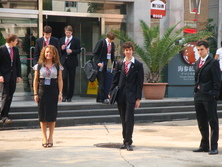 On the way to the fight rooms. Note the big blue suitcase (in the back of the picture) that had to be carried everywhere.
On the way to the fight rooms. Note the big blue suitcase (in the back of the picture) that had to be carried everywhere.The special effect in Angel’s Ghostly Image presentation was that his theory involved a 3D model and therefore, many of the slides contained 3D graphics. We provided 3D glasses and honestly, Avatar is nothing compared to that experience! Our opponence against the team from the Czech Republic, however, was only mediocre and we were far from reaching the score we were aiming for. After that, it was no surprise to find our team ranking only sixth. That was actually not too bad, but didn’t go very well with our goal to get into the finals.
The next morning, we met Sweden and Great Britain, which meant a fight on a high level. Sweden was ranking equally and Great Britain even better than us. Johannes did a good job presenting the second problem, Coupled Compasses, which asked to compute the movement of two compass needles. We had been able to do that in first approximation, but the more details we had taken into consideration, the more complicated our calculations had become and even after the finals, there were questions left that remained unanswered. Although we had originally thought that Coupled Compasses was not among our best reports, the grades were quite good. The Swedish team beat us in the direct duel, however in the overall ranking, we rose to the fourth rank. This made the finals appear realistic for us.
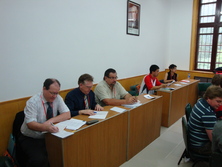 The jury for the second fight.
The jury for the second fight.In seemed to be our fate to fight against good teams. In the third fight, we competed against the team of South Korea, which was leading in the ranking. We were lucky to be able to show one of our best presentations: Electromagnetic Motor. At least we thought it was outstandingly good. The jury argued that it was not detailed enough and not sufficient. Apart from that, an intensive discussion with one of the jurors developed out of his opinion that our theory was crap. Up to now, we have not been able to find out who was more correct. Even long discussions with jurors and professors didn’t help to clarify that issue. We are still convinced that we are right. That’s the cool thing about the IYPT: Nothing can be taken for granted and everything is open for discussion. In that specific case, it was rather exasperating and we had to accept rank five after round three.
The Thunderstorm and Round Four
Perfectly suiting our mood after that fight, we experienced a thunderstorm unlike any we had ever seen in Europe. We couldn’t determine whether it was the incredible amount of rain or the insufficient drainage, but it didn’t take long until the streets were flooded to ankle depth. Everyone tried to hold on to their computers and get onto the shuttle bus as quickly as possible. This bus, however, was open on the sides and nothing could be kept dry. When we were sitting in the air-conditioned dining room, we were freezing and all we could do was hope not to catch a cold.
As it is tradition, we spent our evenings making almost finished presentations even more almost finished, practice reports and write lists for opponences. We had planned to prepare such a list for every single problem beforehand, but as we had expected, this plan didn’t work out. The development of our professionalism, however, did work out very well and as the preparation time for the report is very limited, it was necessary to have a list telling us what to do and who was going to be responsible for which part of the preparation. To guarantee our reports were unique, we included some special effects.
 Team New Zealand in round four.
Team New Zealand in round four.In round four, we met New Zealand, another team that we wanted to outplace. We opposed them in the problem Stearing Engine, which was probably not their very best one. Their grades were mediocre, which meant better chances for us. The problem we presented was Transformers, which we hadn’t started working on long before the IYPT, but it was still surprisingly good. The team from New Zealand, however, scored high in opponence and review and in the end, they won the direct duel. Now, ranking forth, we seemed to re-live 2008: That year, we had just not made it into the finals, missing only 0.1 points.
 A very patriotic Angel.
A very patriotic Angel.The Basketball Tournament
As our achievements in the physics tournament stayed behind expectations, we tried to focus on the basketball match scheduled that afternoon. If it was impossible for us to be first in the IYPT, we at least wanted to win the basketball match! Back in Vienna we had stocked up on merchandise products left over from the European soccer championship and now we were perfectly prepared: With flags, pins, sweatbands and our perfect entrance, in lockstep and whistling the Radetzky March, we quite impressed the Chinese people standing around us.
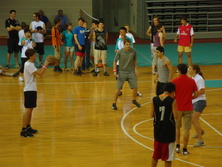 Markus, very sporty!
Markus, very sporty!The gym would have impressed every Austrian basketball player. It was huge enough that we could actually see the smog! We played in teams of three, using one basket only. The lot was beneficial for us: We got a free ticket for the first stage. We easily won the first games. It wasn’t quite a balanced match: Markus used to play in the Austrian national team when he was younger. In the last matches, however, the teams got better and after some games of varying intensity we found ourselves in the finals, playing against Belarus. For quite a long time, it was undecided, given the strong rebound of the Belarusian jurors. In the end, we were the winners and therefore, we can proudly say that we are the best young physicists’ basketball national team in the world! (We should probably also state that just after our success, we lost a game against the Chinese referees.)
Round five
Our chances were not the best. It can be considered bad luck to compete against two rather weak teams in the last prefight. Usually, scores are higher when strong teams are involved. Luckily, we were challenged on Stop a Drip, one of our best presentations. The good thing about this problem was that we had been working on it for a long time and so we had a large amount of videos, pictures and data we could present, which usually increases the scores. Our theory was quite sophisticated, but you never know if it is correct – sometimes, the jury will find a mistake, sometimes you yourself will, maybe years later.
It was one of our most complex presentations and the preparation time had to be used as efficiently as possible. Within only one minute, everything was ready, including a small table and a coat for Markus, the reporter. For the remaining time, we could just sit back and enjoy what was happening: The bottle was opened just the way it should be, and we checked that the wine wasn’t corked. Having done that, the wine was served as a welcome drink, perfectly poured into the glasses without dripping (We were all relieved, it’s not that we are that good in pouring wine into glasses.). While this was going on, the jurors could easily observe the process in a live recorded video on the screen behind us. The jury seemed to be impressed and we scored very high, which made the finals appear to be possible for us. After a good opponence and an excellent review, we could be sure: Two ranks better than before! Ranking second now, we were in the finals!
None of had felt all too well during that week: We were suffering from diahorra, stomach-ache, sickness and fever. At home, some of us would probably have taken a few days off to get well again. At that stage, even being at the IYPT, one of us had to stay in bed for some time: Markus, who was supposed to present in the finals, had 39°C fever and really had to make sure he would get well soon. The only possibility was: Getting healthy within one day. This plan worked out: Still groggy (which one can clearly tell from the video), he presented in the finals.
The Chinese Wall
So, while we were climbing the Chinese Wall, Markus stayed in bed, and Angel also stayed at the hotel to accompany him. The rest of us saw this impressive construction and especially Tim was fascinated, as the video shows:
Tim was kind enough to give a rough translation: "Memo to self: Don't do this again. Ever. It's hot, there's too many people here for my taste. And it's a wall! A wall!"
The Finals
The next morning, it was eventually time for the finals. Although we now had reached our goal to get into the finals, we of course immediately set another one: Not to be third. To actually lose the finals was not quite what we wanted. Being the most motivated team, we were the first to arrive in the fight room and had plenty of time to prepare and check laptops and projectors. After some nice speeches, the Korean team started by presenting Coupled Compasses, which we had presented already. Angel was our opponent, he found enough mistakes to be quite optimistic in the beginning of the discussion. The problem was, however, that the jurors wouldn’t (want to) notice the mistakes and asked us not to talk about our own research, which is forbidden for the opponent. We of course didn’t agree. What we wanted was to show the mistakes in our competitors’ report – but the difference between those two things is not always completely clear. Therefore, our score for the opponence was quite low. Korea’s score, however, was impressively high.
We presented the problem Skateboarder. Especially for that problem, every team seemed to have a completely different approach. The way we had dealt with it had required to measure each movement of the skateboard. Our experimental results and theoretical considerations were well elaborated and quite impressed the jury. We could not only calculate the acceleration out of our measurements, but also predict the optimum movement. There was some negative critique, however, because our explanations were too qualitative. That was, however, only due to the limited presentation time. It still was a quite unique experience for a different reason: How often do you get to skateboard in front of a few hundreds of physicists? Our score was not too bad, but not quite as good as Korea’s.
As we were reviewer in the last stage, it was clear that we could only hope that one of the other teams would score low. We were lucky: New Zealand’s report was not the very best and our review was brilliant. After that, it was clear that we could maintain our rank and we were second in the world championship!
The prize ceremony was not very exciting, there were no surprises. But we have to mention one thing: We got a prize for winning the basketball tournament! The prize was... table tennis racquets! Apparently, the organizers were thinking that, given how good we were at basketball already, we should work on our abilities in table tennis.
The World is Dancing the Waltz
The last activity was a cultural performance from every team. The performance didn’t necessarily have to be about a country’s culture. Sweden, for example, showed the hundredth problem 18 (it’s sort of a tradition at the IYPT to call everything difficult “problem 18”) about chopsticks. In their performance, they kidded those teams having participated in the finals, but we were lucky enough not to be harmed by that. This was quite surprising, given that Markus had almost broken out a tooth of a Swedish girl in the basketball game. A bit too late, New Zealand showed the Hakka of the Maori (before the finals, it would have been rather intimidating), other teams sang traditional songs.
Austria’s cultural performance is traditionally the Vienna Waltz. For some of us, it was just another problem 18. This time, we even had live music, as we had imported a violin from Vienna, on which the Danube Waltz was played. The team of Austria asked everyone to dance and performed the Waltz, on a more or less high level. For all the other nations, it was more of a fun thing. They seemed to like it, and we were even asked to repeat the waltz! For the rest of the evening, the team from Nigeria provided us with more up-to-date dance music.
After the tournament, we took the opportunity to stay in China for some time. We visited Shanghai, climbed the (at that time) highest observation deck in the world and took a ride on the Magnetic Levitation Train. In Beijing, we walked through the Forbidden City and we were invited to visited the Austrian embassy. Next year, we won’t have to travel that far: We’re looking forward to the IYPT2010 in Vienna!
Text: Timotheus Hell and Markus Kunesch, translation by Ulrike Regner
News
July 17 — Problems for the IYPT 2011
The IOC has just finished deciding on the 17 Problems for the IYPT 2011 .
July 15 — Singapore wins the 23rd IYPT
The winner of this year's IYPT is the Team of Singapore followed by Austria, New Zealand and Korea.
July 10 — The IYPT has been officially opened!
President Alan Allinson has just opened the 23rd IYPT.